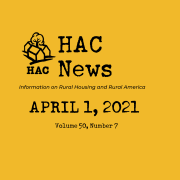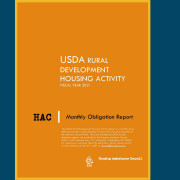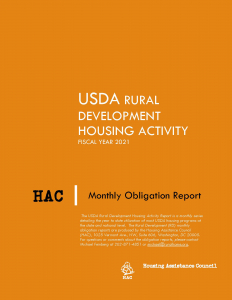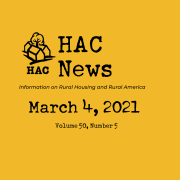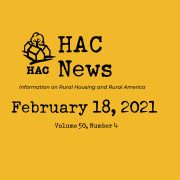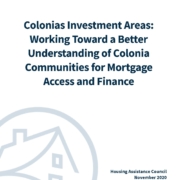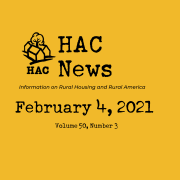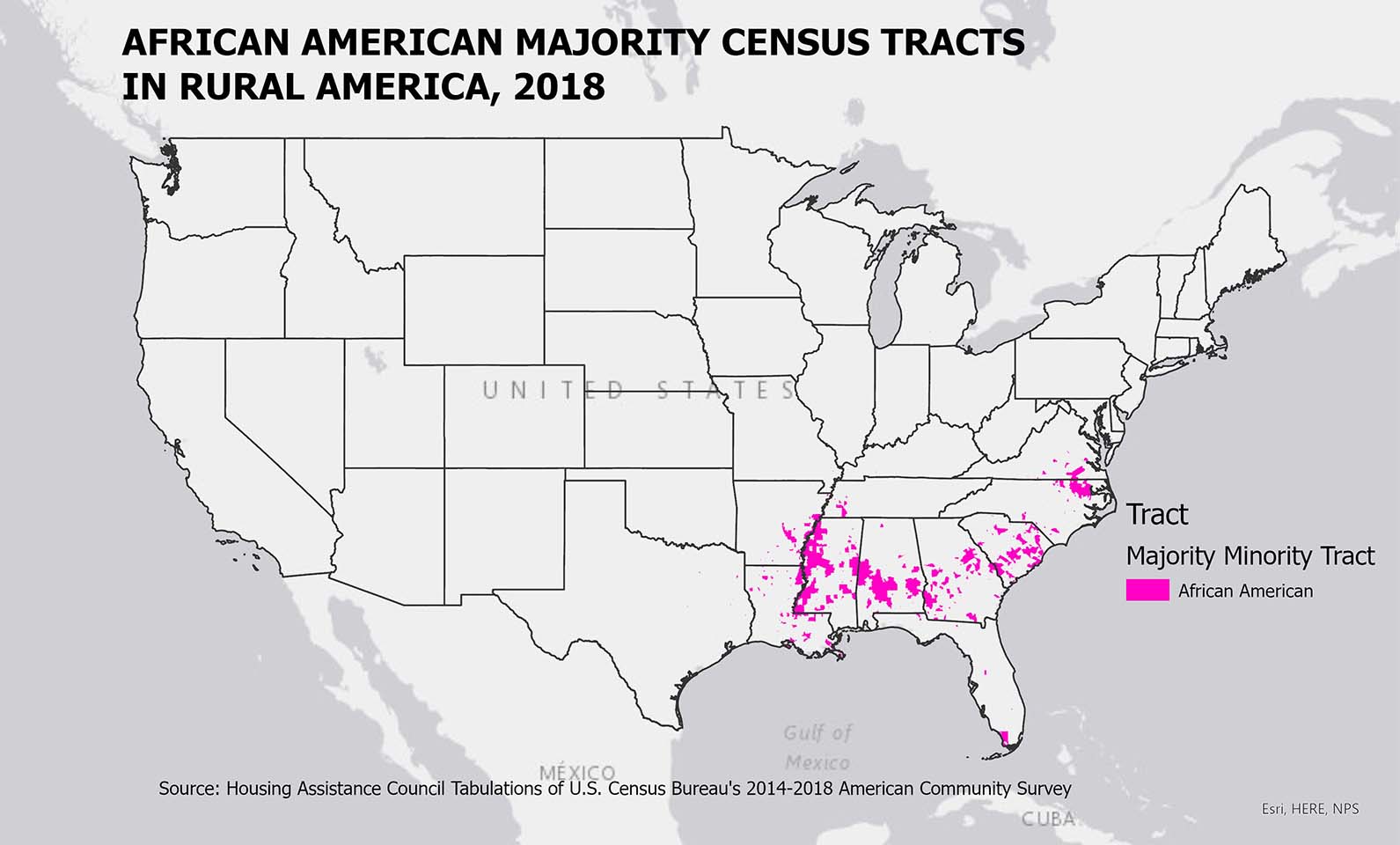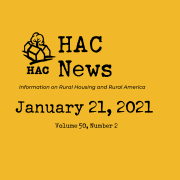HAC News: April 1, 2021
HAC News Formats. pdf
April 1, 2021
Vol. 50, No. 7
TOP STORIES
Eviction moratorium extended through June 30.
The Centers for Disease Control has extended the nationwide eviction moratorium through June 30, with some changes in wording. CDC also posted a new checklist version of the Eviction Protection Declaration for tenants to use. USDA RD announced that the moratorium applies to tenants in USDA-assisted properties. For more information, property owners and management agents can contact their RD servicing representative (on the linked page, click the Contact tab). Tenants can request information from HUD-certified housing counseling agencies.
Agencies announce eviction moratorium enforcement.
After the eviction moratorium was extended on March 29, the Federal Trade Commission and Consumer Financial Protection Bureau warned they “will not tolerate illegal practices” by landlords or property managers trying to evict tenants who cannot pay rent for reasons related to the pandemic. Their joint statement asserts that “both agencies will be monitoring and investigating eviction practices, particularly by major multistate landlords, eviction management services, and private equity firms, to ensure that they are complying with the law.” Evictions that violate the moratorium, as well as other unlawful debt collection practices, can be reported to the CFPB at www.consumerfinance.gov/complaint/ or 855-411-2372.
Infrastructure proposal includes housing, broadband and a new Rural Partnership Program.
The administration released a summary of its sweeping infrastructure proposal on March 31, including several provisions relevant to HAC News readers. HAC supports the inclusion of increased rural housing resources in the infrastructure plan, especially around USDA multifamily preservation and capacity building.
- Acknowledging the severe shortage of affordable housing options in the United States, the White House would invest $213 billion to produce, preserve and retrofit affordable homes, including 500,000 for low- and middle-income homebuyers. The summary does not indicate how most of these funds would be administered, though it does allocate $40 billion for public housing capital needs.
- The administration proposes a new $5 billion Rural Partnership Program “to help rural regions, including Tribal Nations, build on their unique assets and realize their vision for inclusive community and economic development” by supporting locally led planning and capacity building efforts through flexible funding mechanisms.
- The proposal calls for building high-speed broadband infrastructure to reach everyone in the country.
- Rural, tribal and underserved areas are mentioned throughout the proposal, including in the housing section.
HUD withdraws proposed rule on mixed-status families.
In 2019 HUD proposed to change its regulations regarding assistance to families with mixed immigration status. Instead of continuing to allow such families to live in HUD-assisted housing and prorating the amount of their assistance to cover only the eligible family members, the proposal would have prohibited aid to the entire family. The rule was never finalized, and HUD has now withdrawn it.
HAC and NEA present rural photography exhibit.
With support from the National Endowment for the Arts, HAC launched There is More Work to Be Done, a virtual exhibition celebrating the work of acclaimed photographer George “Elfie” Ballis (1925-2010), a long-time friend of HAC and rural housing, along with photos and stories from contemporary photographers who worked with community-based housing organizations in California, Kentucky and Mississippi to capture collective progress while exposing the work that must continue.
HAC celebrates SHOP’s 25th anniversary.
March 26 was the 25th anniversary of HUD’s Self-Help Homeownership Opportunity Program. Over these 25 years, HAC has received and invested over $120 million through SHOP to build 9,896 self-help homes. As the only national SHOP grantee with a specific focus on rural homes, we’re proud of the difference our SHOP investments make in rural America. To celebrate this anniversary, HAC featured a story about the impact of one of our SHOP grantees: Northwest Regional Housing Authority in Harrison, Arkansas.
April is Fair Housing Month.
HUD’s theme for the month is Fair Housing: More Than Just Words. Scheduled events include a virtual celebration on April 7.
RuralSTAT
From 2019 to 2020, the number of people experiencing unsheltered homelessness in largely rural Continuums of Care increased by 8.3%, higher than in other geographies and higher than the 7.5% increase nationwide. Source: 2020 Annual Homeless Assessment Report (AHAR) to Congress, HUD.
OPPORTUNITIES
Paycheck Protection Program extended.
The PPP Extension Act of 2021, signed into law by President Biden on March 30, sets May 31 as the new deadline for small businesses to request PPP loans.
Health hazard reduction funds available for PHAs and IHAs.
The deadline is May 25 for public housing authorities and Indian housing authorities to apply for competitive grants to evaluate and reduce housing-related hazards, including carbon monoxide and mold, in public housing. For more information, contact HUD staff.
Equipment makers encouraged to partner with rural nonprofits.
The Association of Equipment Manufacturers has released a Workforce Solutions Toolkit designed to improve manufacturers’ approach to workforce development. It includes a section on specific challenges in rural places and recommends partnering with local nonprofits to maximize impact. For more information, contact Julie Davis, AEM.
HAC job opening: Community Facilities Housing Specialist.
The Community Facilities Housing Specialist identifies and engages community stakeholders and provides direct technical assistance to rural organizations that are developing facilities such as parks, community centers, public libraries and childcare centers. This includes helping them identify, utilize and apply for financial resources such as USDA Community Facilities grants and loans. This a two-year position and is eligible for telecommuting.
REGULATIONS AND FEDERAL AGENCIES
Input sought on new Rural Energy Pilot Program.
USDA RD requests comments by April 29 on its new Rural Energy Pilot Program, which received $10 million in USDA’s FY 2021 appropriation to help rural communities develop renewable energy. RD will hold an online listening session on April 22. For more information, contact Anthony Crooks, USDA, 202-205-9322.
House hearing examines the state of Black farmers in the U.S.
A House Agriculture Committee hearing on March 25 included testimony from six farmers and farmer advocates as well as Agriculture Secretary Tom Vilsack, covering USDA’s history of discrimination and advice for the $5 billion in debt relief and other aid provided by the American Rescue Plan Act.
Mortgage data collection required for 2021.
The Consumer Financial Protection Bureau has ended several policies, put in place near the beginning of the coronavirus pandemic, that allowed banks and other lenders flexibility in complying with a variety of requirements, including the Home Mortgage Disclosure Act. HMDA data on applications and approvals for mortgage finance will be required again beginning with transactions finalized in 2021. For more information, contact Zixta Q. Martinez, CBPP, 202-435-7204.
USDA revises domestic violence guidance for rental properties.
A March 15, 2021 Unnumbered Letter revises guidance published in November, correcting errors and omissions in the earlier version.
PUBLICATIONS AND MEDIA
HUD reports homelessness increased before the pandemic.
The just-released 2020 Annual Homeless Assessment Report (AHAR) to Congress shows about 580,000 people experienced homelessness in the U.S. on one night in January 2020, with about 18% of them in HUD-defined “largely rural” Continuums of Care. Unsheltered homelessness increased, as it has every year since 2015, although the total is still lower than it was in 2007. About 20% of people experiencing unsheltered homelessness were in largely rural CoCs. HUD has posted data at the national, state and CoC levels.
Guides offer fair housing tools for limited English proficiency.
A Language Access Guide prepared by the Intermountain Fair Housing Council in Idaho provides information and tools for housing providers and consumers, both with and without federal assistance. It explains what requirements apply and what remedies are available for persons with limited English proficiency. The guide is in English but links to numerous resources, some of which are available in other languages. HUD has also released a Housing Counseling Limited English Proficiency Toolkit for its counseling agencies.
“How to improve public health, the environment and racial equity all at once: upgrade low-income housing.”
An environmental health researcher argues that retrofitting and rehabilitating affordable housing saves money, improves the health of residents, and helps the environment.
Fracking left Appalachian counties’ economies worse, research found.
Appalachia’s Natural Gas Counties: Contributing More to the U.S. Economy and Getting Less in Return reports the findings of an Ohio River Valley Institute analysis of data from the 22 counties that produce 90% of the region’s natural gas. While natural gas production increased economic output by 60%, little of the income benefited local economies. The data indicated scant job growth and a declining population in many of the counties involved.
“Census data delay scrambles plans for state redistricting.”
The delay in completing the 2020 Census and releasing the data has added cost, confusion and instability to the redistricting process and will likely come with legal challenges, this AP article explains. Each state will handle the delay in its own way – according to the National Conference of State Legislatures, only about half the states require using the census data for redistricting – but those with 2022 primaries face a time crunch.
HAC
Need capital for your affordable housing project?
HAC’s loan fund provides low interest rate loans to support single- and multifamily affordable housing projects for low-income rural residents throughout the U.S. and territories. Capital is available for all types of affordable and mixed-income housing projects, including preservation, new development, farmworker, senior and veteran housing. HAC loan funds can be used for pre-development, site acquisition, site development, construction/rehabilitation and permanent financing. Contact HAC’s loan fund staff at hacloanfund@ruralhome.org, 202-842-8600.
Please note: HAC is not able to offer loans to individuals or families. Borrowers must be nonprofit or for-profit organizations or government entities (including tribes).

